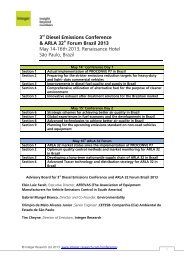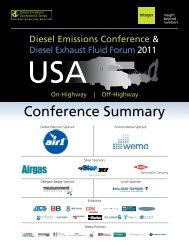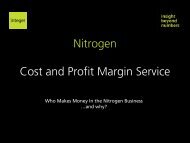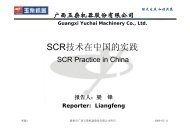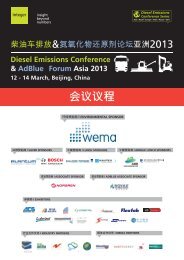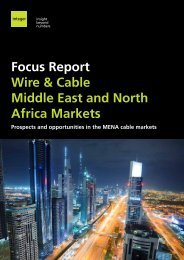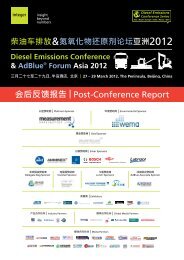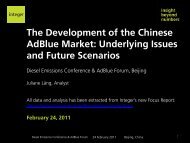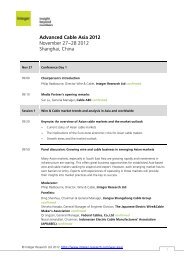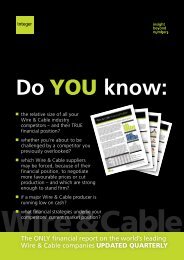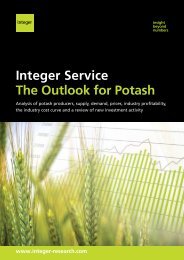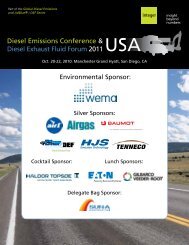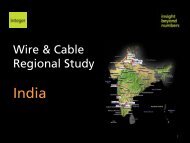Post-Conference Report - Integer Research
Post-Conference Report - Integer Research
Post-Conference Report - Integer Research
Create successful ePaper yourself
Turn your PDF publications into a flip-book with our unique Google optimized e-Paper software.
in<br />
b<br />
n<br />
Analysis (cont.)<br />
in<br />
b<br />
n<br />
routes if they have P7 trucks.<br />
Session 3: Global experience of meeting<br />
stringent diesel emissions legislation<br />
Tim Johnson, Director, Emerging Regulations<br />
& Technologies, Corning gave a technical paper<br />
on the range of new engine technologies and the<br />
advances that have been made in order to reduce<br />
emissions. The resulting effect on a wide range of<br />
emissions was analysed, considering in detail SCR<br />
catalyst placement, DPF substrate properties, and<br />
Diesel Oxidation Catalysts.<br />
Gabriel Branco, Director and Co-founder,<br />
Environmentality moderated Tim Johnson,<br />
Director, Emerging Regulations &<br />
Technologies, Corning, Christian Wahnfried,<br />
Fuels, Emissions & Validation, Bosch Brasil,<br />
Manfred Schuckert, Senior Manager (S/RC),<br />
Daimler AG, and Qingyuan Song, Director,<br />
Advanced <strong>Research</strong> & Technology, Foton<br />
Motor Group in a panel discussion looking at the<br />
global lessons applied to the Brazilian experience<br />
of meeting emissions regulations. Concerns over<br />
the timing of PROCONVE P8 and the readiness of<br />
the industry were discussed. The panel raised the<br />
need to strive for world harmonisation in emissions<br />
legislation, a theme which continued into the<br />
dialogue on Day 2. The importance of OBD as a<br />
tool to operate trucks properly was stressed, and<br />
it was agreed that while engine inspections are<br />
timely and expensive, they are worthwhile.<br />
Ben Patel, Vice President, Emission Control,<br />
Global <strong>Research</strong> & Development, Systems<br />
Integration, Tenneco Automotive took the<br />
opportunity to update the delegates on the<br />
progress of Tenneco’s Hydrocarbon lean NOx<br />
catalyst technology which offers an alternative to<br />
liquid urea SCR. Hydrocarbon LNC technology uses<br />
ethanol instead of urea solution – a timely and<br />
attractive prospect given the availability of ethanol<br />
in Brazil. While the technology requires further<br />
development before its unveiling, the existing<br />
infrastructure in Brazil led Patel to claim that<br />
“ethanol is Brazil’s Diesel Exhaust Fluid”.<br />
Session 4: Emissions control technology<br />
options used to meet PROCONVE P7<br />
and future emissions regulations<br />
Kurt Krier, Global Vice President, Exhaust<br />
Emissions, Dow Automotive presented on the<br />
future of diesel system architectures for use in<br />
PROCONVE P7 and future legislations in Dow’s<br />
AERIFY particulate filter range. The AERIFY<br />
substrate technology has been offered to OEMs<br />
in prototype format, and is expected to be fully<br />
developed by 2014.<br />
Enric Senar - Serra, Product Manager,<br />
Automotive Catalysts, Haldor Topsoe A/S<br />
followed with an overview of the lessons that<br />
have been learned in the last 10 years in Euro<br />
V applications. As a key issue in Brazil, sulphur<br />
tolerance was discussed and it was reported that<br />
at low temperatures, s1200 fuel affects NOx<br />
conversion. The implications of phosphorous and<br />
urea deposits was also highlighted.<br />
Mohamed Gouda, Product Manager, AVL<br />
demonstrated AVL’s engine development process<br />
in using virtual design verification for diesel<br />
powertrain systems. Changing design parameters<br />
in order to simulate diesel engine conditions is an<br />
increasingly popular method in engine technology<br />
design.<br />
Marcio Auada, Product Engineering and VPI<br />
Manager, Cummins do Brasil ended the day with<br />
a roundup of engine development in Brazil since<br />
PROCONVE P7 was introduced, and the advances<br />
in performance in the latest engine range. The P7<br />
engine range was heavily tested over 6.5 million<br />
km, both under environmental conditions, and<br />
with fuels range from s10 to s1500. Cummins<br />
has been working with ARLA 32 distribution<br />
networks to explain the new technology to dealers<br />
and customers, however the expected sales of P7<br />
engines in the first five months of 2012 was far<br />
lower than expected, and has led to production<br />
capacity reduction.<br />
<strong>Post</strong>-<strong>Conference</strong> Analysis: Diesel Emissions <strong>Conference</strong> & ARLA 32 Forum Brazil 2012<br />
5



